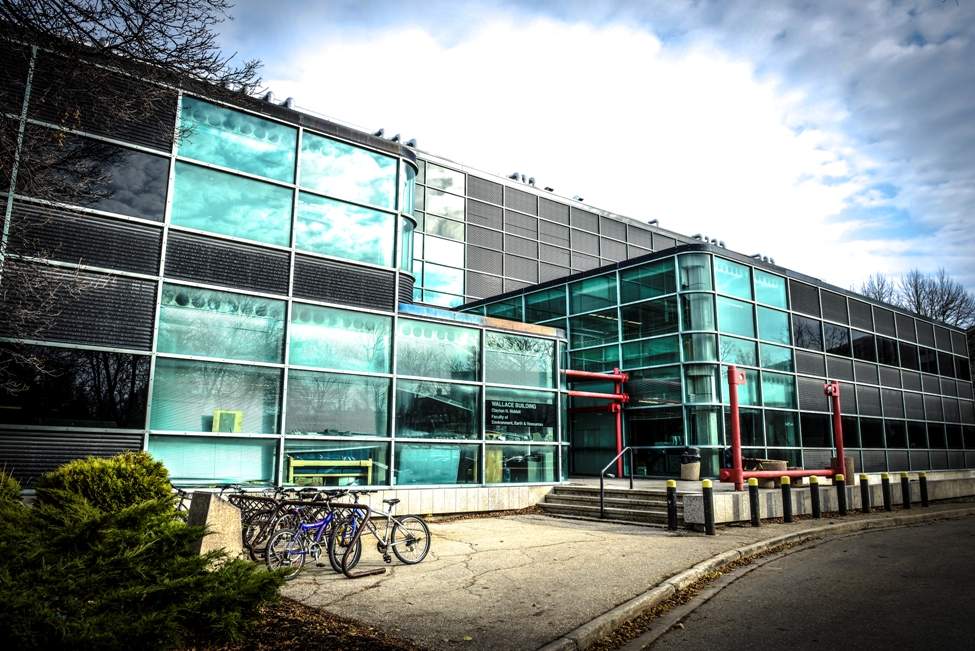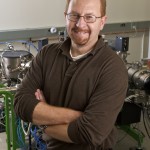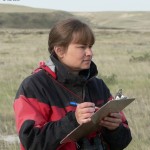
A lifetime in just ten years
Youngest Faculty at University of Manitoba celebrates 10 years of impacting the world
The Clayton H. Riddell Faculty of Environment, Earth, and Resources at the University of Manitoba is celebrating its tenth birthday and all its successes.
Its roots extend to 1910 when the Department of Geology and Mineralogy was established. Then in 1986 the department moved into the newly built Wallace Building, its current home. It changed its name to the Department of Geography and then about six years later, noting that geological sciences had a changing role and future in society, it began promoting the formulation of a new faculty. In 2003, the Department of Geological Sciences, the Department of Environment and Geography, and the Natural Resources Institute Faculty, merged into a new faculty. In 2005 it was named after alumnus Dr. Clayton Riddell [BSc/55]. It became the home of multi-disciplinary researchers who would satisfy the Faculty’s new, visionary goal of understanding the changing Earth, environment, and human condition, and to disseminate and apply this knowledge for the benefit of the present and future. It wanted to study the Earth as a system – a pioneering idea at the time – so it could understand how civilization can use resources with the least disruption to that system.
As the Faculty’s Dean, Norman Halden, explains:
With the rise of western provincial economies there is increasing recognition that Canada still has a strong resource based economy. As human population continues to rise we can anticipate increased demands to supply minerals, energy and food to the world. Furthermore, as climate continues to change, we can anticipate different regions in the world being affected by population shifts and access to transportation – our Arctic. If we continue to exploit resources under these conditions we need to do it in such a way as to minimize the environmental impact – we need to apply a knowledge approach to a knowledge based resource economy. We need to monitor environmental change, apply such technologies and processes as are needed to do this, and inform policy makers so that we maximize the “value added” aspect of using our resources.
New technologies are allowing us to analyze natural materials in novel ways. We can routinely analyze elements at the micron scale and at the parts per billion level. We can measure changes in the environment as traces are left behind in minerals. We can even measure how these changes affect life. We have a good understanding of how the Earth has responded to environmental changes in the past, and we are getting better at predicting changes that will occur in the future.
While the science of environmental change has become quite sophisticated, our understanding at a societal level of where food, minerals and energy comes from has not kept pace. An important change that needs to take place is that people in general need to engage in an honest conversation about what constitutes a resource, where resources are located, and what our consumption patterns are doing to the Earth.
To this end, the Faculty has so far educated over 800 undergraduate and over 200 graduate students, with two grads earning the Governor General Gold Medal and one earning the Silver. In the past year alone the Faculty’s cooperative education program has grown to provide over 75 work placements with more than 50 employers, and since 2012, two of these students won the U of M Cooperative Education Student Champion Award.
Enrollment in first-year classes have increased 29 per cent since 2003, which may be attributed to its creative and engaging courses such as Earth: A User’s Guide, and the fact that instructors such as Lisa Ford receive the Olive Beatrice Stanton Award for Excellence in Teaching, as she did in 2013. Add to this the fact that the Riddell Endowment fund has awarded $27,000 in undergraduate admission scholarships and over $165,000 in graduate entrance scholarships to date, and it becomes even clearer why this Faculty continues to grow.
It’s also home to some of the best laboratories of its kind, such as the Sea-Ice Environment Research Facility (SERF), and some of the best professors in their fields. Distinguished Professors like Frank Hawthorne, winner of the 2008 Killam Prize in Natural Sciences, the 2009 Carnegie Mineralogical Award, the 2010 the Bancroft Medal of the Royal Society of Canada, and the 2013 Roebling Medal of the Mineralogical Society of America.
It’s also home to new rising stars like Environment and Geography’s assistant professor Jeffrey Masuda, who received the Canadian Institutes of Health Research’s New Investigator grant in the area of Knowledge Translation (2010-2015). He is also the founding Director of the Centre for Environmental Health Equity, a knowledge translation platform for enhancing linkages between community, research, and policy in order to address socioenvironmental inequalities in health.
The Faculty is home to four Canada Research Chairs (CRCs) and a Canada Excellence Research Chair (CERC):
CRCs: David Barber (Arctic System Science), Fikret Berkes (Community-Based Resource Management),Mostafa Fayek (Isotope and Environmental Geochemistry), and Frank Hawthorne (Crystallography and Mineralogy).
CERC: Søren Rysgaard (Arctic Geomicrobiology and Climate Change).
Here’s a Q&A with some Clayton H. Riddell Faculty of Environment, Earth, and Resources faculty members.
Mostafa Fayek, Canada Research Chair in Isotope Geochemistry, professor of Geological Sciences.
What do you know now that you didn’t ten years ago?
MF: Ten years ago we were only beginning to understand that fluids and materials in natural systems behave differently and have different properties at the nano-scale, micro-scale and macro-scale. We also now know how to scale up the information that we obtain from the nano- and micro-scales to the macro-level to better understand the geological and anthropogenic processes that concentrate economically significant minerals, which are a benefit to society, and harmful toxic elements.
What has happened in your field?
MF: One of the major changes in geochemistry over the past 10 years has been the significant improvement in technology. Lasers and ion beams coupled with state-of-the-art mass spectrometers, interfaced with fast, user-friendly computer programs have allowed us to obtain information (e.g., trace element concentrations and isotopic compositions) at the nano- and macro-scale from complicated geological and archaeological materials while maintaining geological and archeological context. Enhanced electronics and detectors have significantly improved precision and accuracy in our measurements, which, in-turn have allowed us to detect more subtle patterns related to climate change and develop better models to predict the location of economically significant resources.
What is the future and current state of geology?
MF: Students considering geology as a discipline should know that geology is no longer strictly about the study of rocks. Geology as a discipline has grown to encompass many different fields that are relevant to society. These areas include, environmental geochemistry (climate change, life through geological time, understanding toxic element mobility and disposal of nuclear waste), the study of gem minerals (How do they form? Where do they come from? Are they real?), archaeometry (What did ancient people trade and eat, and how did ancient populations travel?), geoforensics (using geological techniques and knowledge to help detectives and government agencies track down persons of interest related to crime).
Feiyue Wang, Professor of environment and Geography, Associate Professor of Chemistry, SERF Project Lead
What do you know now that you didn’t ten years ago?
FW: Working in the field of mercury transport and cycling in the Arctic marine ecosystem, I know now what’s accumulated in marine mammals is not just reflecting what’s in the air (which is primarily transported from the south), but also driven by climate induced changes in the Arctic Ocean, such as changes in the sea ice environment and in the structure, function and dynamics of Arctic marine food webs. Ten years ago we were at the verge of that discovery, but many remained skeptical.
Ten years ago we either ignored the sea ice environment in our studies of global cycling of contaminants such as mercury, or treat it as a seasonal lid blocking their exchange between the atmosphere and the ocean. We now know that sea ice and the overlying snow can initiate or participate in many chemical and biological processes that are significant both regionally and globally.
What has happened in your field?
FW: One of the major developments in my field is the increasing recognition and realization of interdisciplinary collaboration and cross-cultural learning. This is by no means new, as environmental science has always been relying on interdisciplinary collaboration and cross-cultural learning to understanding complicated and dynamic environmental system and its relationship with human. However, the need for such approaches has never been greater when we are dealing with contemporary environmental issues under a rapidly changing climate, such as what has been transpiring in the Arctic.
From that perspective the creation of our faculty was a very timely and wise move in the right direction. Since its inception, our faculty and its staff and graduate students have been playing a leadership role in addressing Northern environmental issues through interdisciplinary collaboration and Two Ways of Knowing.
What do you think will happen in the next ten years?
FW: Unless scientists collectively dropped their balls, the Arctic Ocean will look (literally) very different by the end of the next decade. We might be down to the last pockets of multiple-year ice, if it still exists at all. We will see much more ship traffic across the Arctic Ocean, even during winter. The oil, gas and mineral industry will be moving from exploration to actual drilling, mining and production. Those changes are happening so fast that it becomes a race for us to get a chance to even think about many of the unknowns before these changes occur. For my own research, now that global emission of mercury is being put under control (the Minamata Convention on Mercury is to be signed by international bodies in October this year), I will be more interested in how the existing mercury in the Arctic system behaves under such dramatic changes.
Nicola Koper, Associate Professor and Associate Head of the Natural Resources Institute
What do you know now that you didn’t ten years ago?
NK: The most important academic discovery I’ve made while teaching and doing research with the Clayton H. Riddell Faculty of Environment, Earth and Resources is that grassland songbirds – which have declined more than birds of any other habitat in North America – are extraordinarily sensitive to conversion of native habitat to any other use. As humans, we drive by an ethereal purple-blue flax field, or a brilliant gold canola field, and we think it’s beautiful. And it is! But to our native grassland species, not only does cropland mean the loss of breeding habitat, but even those native prairies near cropland become dangerous or less desirable. That means that converting native habitat for agricultural purposes has resulted in the functional loss of much more habitat than we think, and this habitat loss has contributed to dramatic declines in native bird populations.
I have enormous respect for a few members of the public who have made amazing strides in prairie conservation, in ways that will help combat these population declines. My research has shown that we have lost so much tall-grass prairie in Manitoba that the small remnants that are left are no longer self-sustaining ecosystems … even though, historically, tall-grass prairies would have stretched as far as the eye can see in many parts of southern Manitoba. Only those tall-grass prairies that have been actively managed, using methods ranging from hand-pulling weeds to prescribed burns, have increased in size or quality over the last 2 decades; on average, prairies that have been left to their own devices have declined in size and quality. Without continuing active management of the few prairies we have left, by volunteers and organizations such as Nature Conservancy Canada, Nature Manitoba, and Manitoba Conservation, we will certainly lose those few tall-grass prairies that we have left, perhaps in our lifetime.
But agriculture can have a bright side, too. North American prairies evolved in the presence of two great ecological disturbances – fire, and grazing by massive herds of free-ranging native grazers, such as bison. Sadly, we’ve extirpated bison from Manitoba’s prairies, and understandably, we control and limit the spread of almost all prairie fires. However, domestic cattle provide many of the same ecological disturbances to prairies that used to be provided by fire and native grazers. Now, not only is cattle grazing compatible with grassland bird conservation; in the long run, Canadian prairies, and the species that inhabit them, depend on our (primarily beef) cattle industry for their conservation. This means that we can achieve a win-win-win scenario – for conservationists, cattle producers, and prairie wildlife – if we work together. In the next decade, I’d like to see prairie ecologists go beyond talking with each other, to making effective partnerships with cattle producers, so we can translate our knowledge into real-world conservation actions.
Research at the University of Manitoba is partially supported by funding from the Government of Canada Research Support Fund.









